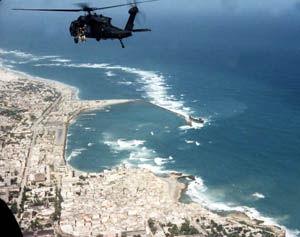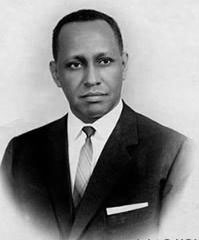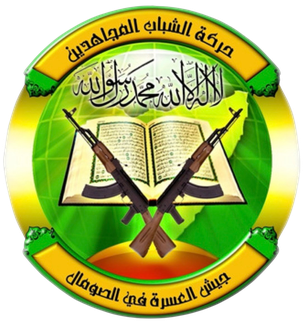Related Research Articles

The Somali Armed Forces are the military forces of the Federal Republic of Somalia. Headed by the president as commander-in-chief, they are constitutionally mandated to ensure the nation's sovereignty, independence and territorial integrity.

The Battle of Mogadishu, also known as the Black Hawk Down incident, was part of Operation Gothic Serpent. It was fought on 3–4 October 1993, in Mogadishu, Somalia, between forces of the United States—supported by UNOSOM II—against the forces of the Somali National Alliance (SNA) and armed irregular citizens of south Mogadishu. The battle was part of the broader Somali Civil War that had begun in 1991. The United Nations had initially become involved to provide food aid to alleviate starvation in the south of the country, but in the months preceding the battle, had shifted the mission to establishing democracy and restoring a central government.

Ali Mohammed Gedi, popularly known as Ali Gedi, was the Prime Minister of the Transitional Federal Government (TFG) of Somalia from 2004 to 2007. He was relatively unknown in political circles upon his appointment as prime minister in November 2004. He is affiliated with the Abgaal subclan of Mogadishu's Hawiye clan, one of Somalia's four most powerful clan 'families'. He narrowly survived a suicide attack on his home that left at least seven people dead on June 3, 2007.

The Hawiye is the largest Somali clan family. Members of this clan traditionally inhabit central and southern Somalia, Somaliland, Djibouti, Ethiopia and Kenya. They are also the majority in the capital city, Mogadishu.

The Somali Civil War is an ongoing civil war that is taking place in Somalia. It grew out of resistance to the military junta which was led by Siad Barre during the 1980s. From 1988 to 1990, the Somali Armed Forces began engaging in combat against various armed rebel groups, including the Somali Salvation Democratic Front in the northeast, the Somali National Movement in the northwest, and the United Somali Congress in the south. The clan-based armed opposition groups overthrew the Barre government in 1991.
Sheikh Hassan Dahir Aweys (English: Hassan Dahir Aweys (Somali: Xasan Daahir Aweys, is a Somali political figure from the Habargidir/Ayr subclan within the Hawiye clan. During the regime of Siad Barre, Aweys was a colonel in the Somali National Army during the 1977 Ogaden War against Ethiopia. He was decorated for bravery for his part in 1977 the war. At an early stage in the fighting, Sheikh Aweys captured Abdullahi Yusuf and put him in jail. Sheikh Aweys later became a leader of Al-Itihaad al-Islamiya, which was destroyed in the late 1990s by a force led by Abdullahi Yusuf and funded by Ethiopia.
Abgaal is a sub-clan of the Hawiye and the even larger Samaale clan. It is one of the major Somali clans and has produced many prominent historical Somali figures including 3 presidents, and the father of the Somali military.
Ayr, Muhammad Madarkicis Hiraab is a Somali clan, part of the larger Habar Gidir Hawiye clan. Ayr has two full siblings Sifaadle Madarkicis And Saruur Madarkicis.

The 2006 Islamic Courts Union offensive is the period in the Somali Civil War that began in May 2006 with the Islamic Courts Union's (ICU) conquest of Mogadishu from the Alliance for the Restoration of Peace and Counter-Terrorism (ARPCT) and continued with further ICU expansion in the country. Following the outbreak of the war on December 21, 2006; by December 24, direct Ethiopian intervention in the conflict in support of the Transitional Federal Government (TFG) was no longer denied by the Ethiopian government. The Eritrean government denied any involvement despite Ethiopian claims to the contrary.

The Habar Gidir is a major subclan of the Hawiye. The clan has produced many prominent Somali figures, including the first Prime Minister of Somalia Abdullahi Issa Mohamud and Somalia's fifth President Abdiqasim Salad Hassan.
The Somali Rebellion was the beginning of the civil war in Somalia that occurred in the 1980s and early 1990s. The rebellion started in 1978 when President Siad Barre began using his special forces, the "Red Berets", to attack clan-based dissident groups opposed to his regime. The dissidents had been becoming more powerful for nearly a decade following his abrupt switch of allegiance from the Soviet Union to the United States and the disastrous 1977-78 Ogaden War.

The fall of Mogadishu occurred on December 28, 2006, when the militaries of Somalia's Transitional Federal Government (TFG) and Ethiopian troops entered the Somali capital unopposed. It came after a swift string of TFG and Ethiopian military victories against the Islamic Courts Union (ICU), which had its headquarters in Mogadishu before it fled south.
Mohamed Omar Habeb, commonly known as Mohamed Dheere or Mohamed Dhere, was a Somali faction leader based out of the city of Jowhar. He hailed from the Abgaal subclan of Hawiye. He also had significant influence on the northern parts of the capital Mogadishu where he controlled a militia of around 400 men.

Harakat al-Shabaab al-Mujahideen, more commonly known as al-Shabaab, is a Salafi-jihadist military and political organisation based in Somalia and active elsewhere in East Africa. It is actively involved in the ongoing Somali Civil War and incorporates elements of Somali nationalism into its Islamist cause. Allegiant to the militant pan-Islamist organization al-Qaeda since 2012, it has also been suspected of forging ties with al-Qaeda in the Islamic Maghreb, and al-Qaeda in the Arabian Peninsula.
Over the course of the Somali Civil War, there have been many revolutionary movements and militia groups run by competing rebel leaders which have held de facto control over vast areas within Somalia.

The Battle of Mogadishu began on 21 March 2007 in the Shirkole area of Mogadishu between Somali Transitional Federal Government forces and allied Ethiopian troops, and Islamist insurgents. The battle usually includes the dates, when referenced, in order to distinguish it amongst the nine major Battles of Mogadishu during the decades-long Somali Civil War.
The Sheekhaal (var. Sheikhaal, also known as Fiqi Omar, is a Somali clan. They inhabit Somalia, Ethiopia, Djibouti and with considerable numbers also found in the Northern Frontier District in Kenya.
The Karanle is a major Somali, sub clan of Hawiye. The Karanle inhabit Galgaduud, Banadir, Mogadishu, Hiiraan, Shabeellaha Hoose, Lower Juba and Mudug regions in Somalia; the Somali Region of Ethiopia; the region of Oromia surrounding the city of Harar and North Eastern Province in Kenya.

Jubaland, the Juba Valley or Azania, is a Federal Member State in southern Somalia. Its eastern border lies 40–60 km (25–35 mi) east of the Jubba River, stretching from Gedo to the Indian Ocean, while its western side flanks the North Eastern Province in Kenya, which was carved out of Jubaland during the colonial period.

Hassan Ali Khaire, popularly known as Hassan Khaire, is a senior politician and is the former Prime Minister of Somalia. He was appointed on 23 February 2017 by Somalia President Mohamed Abdullahi Mohamed "Farmaajo" and resigned on Saturday July 25, 2020 after MPs passed a disputed vote of no confidence.
References
- Williams, Paul D. (2018). Fighting for Peace in Somalia: A History and Analysis of the African Union Mission in Somalia. Oxford University Press.